Report by Josh
Kaplan
The Seattle Union
Record was a major Seattle area labor newspaper of the early
twentieth century. With a publication run of nearly thirty years, the paper was a voice of labor during a dynamic period of Seattle’s labor history.
Published by the Seattle Central Labor Council (and its predecessor, the
Western Central Labor Union, until 1905), the Union Record was a
full coverage newspaper, not merely a newsletter of the CLC. The paper’s
broad coverage of local, national, and international events provides insight
into the attitudes of Seattle’s working people and helps us understand the
world they lived in.
This report studies The Seattle Union Record from January 20, 1912
through November 28, 1914. George T. McNamara was the editor and manager of
the Union Record at the beginning of this period, but beginning with the
April 12, 1913 edition, Harry B. Ault assumed this position. The following
review will discuss the paper’s overall characteristics, its intended
audience, its regular features, its typical layout, and its overall
message. This review will also describe the Union Record’s coverage
of major events in this time period and evaluate the stance the paper took
on many issues.
Organization of the Seattle Union Record
While the Seattle Union Record was indeed a full coverage newspaper
that contained articles about major national and international issues, its
organization shows that it was clearly geared towards union members. The
second page of every edition was headlined with “Co-operation Means
Success,” a phrase that often graced the top of additional pages as well.
The paper also featured several regular weekly sections dedicated to other
labor councils based in the Seattle Labor Temple. A full page was dedicated
to the Building Trades Council and another, smaller section, titled the
“Weekly Department of Women’s Label League, was dedicated to local women’s
labor events. In the middle pages of the paper, readers found both the
“Directory of Labor Organizations” and a “Roster of Unions”, which provided
the contact addresses for a large number of locals. . A particularly
interesting feature of the paper was its “Unfair List”, a constantly updated
list of local businesses which maintained business or hiring practices
deemed unfair to labor. The Union Record also reserved space for an
editorial page and frequently featured cartoons. In 1914, the paper began
to run a regular section entitled “A Page for the Miners,” in response to
the violent struggles of mine workers in Colorado and Michigan. These
“Miners’ Pages” contained stories about the mine workers, cartoons, and
messages of solidarity. Indeed, the expressions of solidarity expressed on
these pages reflected The Seattle Union Record’s ongoing commitment
to build bonds between all varieties of working people.
Advertising to the workingman Just like
traditional newspapers, advertising had a significant presence in the
Union Record. . The range of products and services that advertised to
the union crowd covered most every good and service imaginable. One
similarity among the many advertisements was the wording and symbols
companies used to tout their union friendly practices or exclusive use of
union labor. An interesting ad for the Black and White Hat proudly declared
their hats to be “The man kind”. Such wording was used to appeal to the
manly pride of workingmen. McCormack Bros. proclaimed that their “clothes
are honor-made and sold by card men,” another appeal to the honor and
dignity of workingmen. Lawrence Morgan advertised their union made cigars
with a more straightforward approach, declaring simply that “They Are Good”. Leisure
activities were also advertised. The J. & H. Bar on Occidental Ave.
advertised wines, liquors and cigars under the banner of “The Only Strictly
Union Saloon in the City” and continued with “we are union from basement
floor to chimney top.” For the union man looking to end a hard day with
dancing, Dreamland on 7th and Union St. claimed to be “the only Union
Dancing Pavilion in Seattle.” If drinking at home had more appeal, Rainer
Beer advertised itself as “a fountain of health and happiness”. One can only
assume this was the early 20th century’s version of beer ads featuring girls
in bathing suits washing cars, dancing, or partying on the beach. Advertisements were not
only geared towards men. A “great premium offer” for a lot in the aqueduct
city tract was promised to “the most popular lady member of organized labor”
as part of a contest for women who purchased a yearlong subscription to the
Union Record for $1. The Scandinavian American Bank advertised savings
deposits for women, using the same appeal of pride and honor, yet geared
towards the working woman. “The woman who makes her own way in the world”
was encouraged to open an account, and the bank proudly declared that
“nearly 8,000 of the 24,000 depositors of this bank are women.”
The message of the Seattle Union Record Solidarity is
perhaps the theme that best defines the message of the Union Record.
More than simply conveying the news, the paper served as a rallying cry for
the labor movement and union men and women as a whole. Stories frequently
challenged readers to stand up and take action, or fulfill their duties to
the labor movement. Stories depicted most issues in the context of the
greater struggle between justice seeking working people and tyrannical
employers. To this end, articles supported working-class activism and
championed workers’ sense of decency, principle, pride, and honor. In a
short article titled “Men with Principle, or Principle without Men?” the
paper expressed its support for Paul Mohr and George McNamara, two union men
running for city council, by stating that “those among our citizens desiring
constructive legislation along right lines will make no mistake in voting
for men who created principles and are the builders of their own platforms…”
(02/03/1912) A cover page from July, 1914 inviting workers to the weekly
Labor Temple Meeting also conveyed this theme. In bold print, the headline
exclaimed, “Solidarity – Labor Forward,” and the subtitle below read, “The
Watchword Is “Solidarity.” (07/11/1914) Another
consistent theme of the paper was its use of language that portrayed the
issues of the day in the terms of class war. There was also no illusion of
unbiased coverage. The Union Record almost always took a strong and
clear stance on the stories it covered. Employers supportive of anti-union
legislation, other actions that undercut the labor movement, or otherwise
unfriendly to workers were characterized as evil and assailed as enemies of
the readers. During a campaign against the Bon Marche, a popular Seattle
department store, for unfair labor practices, an article titled “Shall the
Weak Bear the Burden?” stated that “the fight against the Bon Marche is a
fight for those who cannot help themselves.” (April 26, 1913) One cover page
story, “Ballard Shingle Weavers Again Revolt” decried the industry in
question as a “strong-hold of non-unionism” and called for fellow union
members to support their brothers. Another headline on this same cover cast
the honorable union man as a fighter against the unjust. “Clerks Fight
Against Exploitation of Weak” began by framing the conflict as another
uphill fight of the David of labor versus the Goliath of unjust employers,
claiming “times without number are the vigilant workers of organized labor
confronted with the doubting”. (April 12, 1913) Time and time again, The
Seattle Union Record evoked the rhetoric of class conflict and class war
to argue that solidarity was necessary for workers to establish a just and
fair society. With such an
emphasis on working-class pride and honor , the Union Record was
understandably unkind to men it considered dishonorable, cowardly or
unprincipled. An article titled “Man with the Yellow Streak” was unabashedly
critical of such men and called on readers to avoid associating with these
sorts of individuals.
“Never choose a man who has a yellow streak to be your friend; never permit
yourself to follow a man that carries the yellow, regardless of how loud he
may shout and the grievances he may rave about. Such men are dangerous and
treacherous; he will coach you on and desert at the first scent of a real
fight.… He can’t help himself, because he isn’t man enough to own up and ask
for assistance. He won’t tell you what is wrong with him. He wears the
velvet of false pride over his threadbare patch, and you only see it when
it’s too late and his cloak drops and shows his tattered courage.” (April
12, 1913) Scabs, the name given to
strike breakers and nonunion laborers, were portrayed as the lowest form of
enemy to the labor movement. In a headline article titled “Scabs Shipped
Out,” the subtitle declared that the “Captain in charge of troops in
Trinidad District turns back five degraded specimens of humanity who attempt
to scab.” (May 16, 1914) One was likely certain to readers of the Union
Record: being on the bad side of the paper’s staff was a distinction to
be avoided.
Race and gender in the Union Record Early
twentieth century Seattle workers and unions were constantly divided over
questions of race and gender. While some factions argued that racism and
sexism were tools used by employers to divide the working-class and workers
should be fighting the bosses and not themselves, others believed that
working-class solidarity was the privilege of whites. . But surprisingly,
the Union Record had little to say about race relations. The article
“Pacific Northwest Immigration Convention”, written by Charles Perry Taylor,
was a summation of events at a meeting about the place of foreign-born and
nonwhite workers in the labor movement.. Taylor wrote that speakers
“described at length the squat labor performed by Japanese in beet sugar
fields of California during hot weather, and how the Hindu and other
long-legged long-backed laborers were not so satisfactory as the Japanese.”
(March 2, 1912) As this article shows, Asians were the target of negative
attitudes and racist opinions. But overtly racist articles were relatively
rare, and occasionally a writer took a position against Anti-Asian bigotry,
as in the March 1913 piece titled “Rainier Beach after the Japs.” The
article critiqued the Rainier Beach Improvement Club’s attempt to
discriminate against Japanese immigrants and sought to expose “the lie…that
there is no anti-Jap feeling in Seattle.” Black workers
were generally portrayed positively in the Union Record. In fact,
the paper argued that solidarity between white and black workers was strong
and they had a common enemy in employers. A piece in the September 13, 1913
editorial section titled “Organized Labor and the Negro” included very
inclusive language intended to bond white and black laborers together.
“…white workers need not fear unfair competition from him for the job, as
the Negro would not be satisfied with any less bearable conditions than his
white brother. The result of this action on the part of the unions has been
the formation of many Negro organizations, especially in the southern
states, where are being developed hundreds of skilled Negro mechanics who
take second place to none.” … “There is room in the labor movement for
all workers, whether white, brown, black or yellow, just as soon as any of
them desire to become part of it.” (September 13, 1913)
Overall it seems that the
Union Record was inconsistent when it came to race. On one hand, the
paper used racist and divisive language and held many bigoted opinions. But
on the other hand, it also frequently decried racism and sought to
strengthen white-black working-class solidarity. For the most
part, women were treated with respect in the Union Record. Not only
was there a special section dedicated to the local women’s labor group,
articles frequently paid respect to the women who fought alongside men for
the cause of labor. One such example appeared in the May 30, 1914 edition
under the title “Economic Organizations of Women Great Driving Power.” The
article stated that “Label Leagues [are] of inestimable value in obtaining
better working conditions” and continued that “there have been many great
women in history, women who have risen above convention, custom and
precedent, and left their mark indelibly upon the period in which they
lived.” (March 30, 1914) From the perspective of the paper, women’s
purchasing power and willingness to stand up to the bosses gained them a
great deal of reverence and respect.
The Bon Marche Dispute During the
1912-1914 period, a struggle between workers and the Seattle retailer, the
Bon Marche, was covered in great detail in the Union Record—in fact,
barely a week went by without an article discussing this dispute. An article
titled “Bon Marche Adds Insult to Injury” commented on statements the
retailer issued to its employees. The article began by reprinting a message
the Bon March printed on envelopes it issued to its workers:
“Don’t be one of those who are always ready to fight for their ‘right.’ This
‘rights’ business is a joke. Some people feel offended if they are asked to
do part of another’s work, or if anything not essentially part of their
particular duties is asked of them. Don’t worry so much about your ‘rights,’
but use ‘horse sense.’ You won’t lose anything by having a reputation for
being ‘willing.’ It doesn’t sound smart, but that little word ‘success’ is
bound up in it.”
-THE BON MARCHE April 5th, 1913
Inside the envelope was the $5 weekly wage the Union Record deemed unfairly
low. In January of 1914, the piece titled “Bon Marche Shows Its Teeth”
alerted readers to a notice placed in every window of the Bon Marche that
stated “This firm is a member of the Employers’ Association
and Employs its help For Efficiency Only.” (January 10, 1914) Two weeks later an article stated that the “building
[will] be picketed until settlement is Reached; Label League Big Factor”
(January 24, 1914) Following the resolution of the long-standing
disagreement, the Bon Marche appeared to swallow its pride and agree to
union demands—in fact, the May 30, 1914 printing of the Record included an
advertisement for the store. Given the strength and size of the labor
movement in Seattle, it is understandable that the Bon Marche sought to
regain lost union customers as quickly as possible. And while the add never
admitted to unfriendly labor policies, it did feature the logo for the
union made Black Bear Overalls brand.
Other businesses also employed the tactic of courting union members after
labor disputes had been settled. Kristoferson’s Dairy was called out as
unfair in the February 3, 1912 edition, gaining mention in a small article
titled “Unfair Dairies and Why.” In the April 20, 1912 printing the paper
“had the pleasure of announcing” that Jersey Dairy and Kristoferson’s were
removed from the unfair list. Shortly after, ads for Kristofferson began
appearing in the paper. Examples such as these
show that Seattle’s labor movement had a good deal of power at this
time. They also show that the Union Record played an important role
in coordinating and organizing boycotts against unfair employers.
The Colorado Mine Strikes Perhaps the
most heavily covered national labor news of this time involved the plight of
striking miners in Colorado and Michigan. Upset over horrid conditions and
abysmal wages, mine workers demanded changes from mine owners. The addition
of the “Page for the Miners” section guaranteed weekly coverage of these
strikes. In a March 7, 1914 article titled “Power of Calumet & Hegla Co.”,
special correspondent Arthur Jensen questioned the unchecked economic and
political of copper mine owners. “We have seen the local leaders of the
Progressive party, the Republican governor of the state, the Democratic
leaders of the House committee, the local business men and the New York
detective agencies meekly bow to the strong will of the copper companies”
wrote Jensen. Indeed this important event involved all levels of government
and was of chief concern to the labor movement as a whole. The Union
Record’s constant coverage of the events was typical of the paper’s
commitment to labor causes, large or small.
Voice of a Movement
The Seattle Union Record
is an important part of Seattle’s labor history. Its pages highlight many
major labor issues of the early twentieth century. It provides the context
for major national and international issues and is also a remarkable lesson
in Seattle history. Above all else, the Seattle Union Record gave the
labor movement a voice and helped workers stay connected to national and
international issues..
|
Click to enlarge
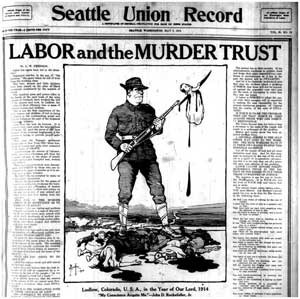
(May
2, 1914)
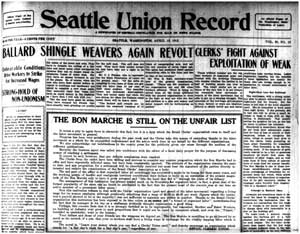
(April
12, 1913)
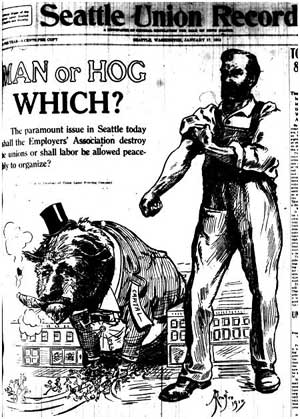
(January
17, 1914)
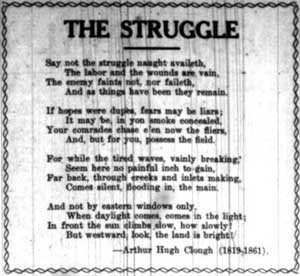
(April
19, 1913)
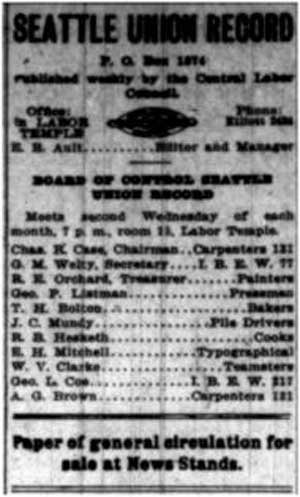
(April
12, 1913)
The Seattle Union
Record was a major Seattle area labor newspaper of the early
twentieth century. With a publication run of nearly thirty years, the paper was a voice of labor during a dynamic period of Seattle’s labor history.
The Seattle Labor
Movement
The primary purpose of the
Seattle Union Record was to report on local union news. The
paper contained articles about struggles, strikes, and lockouts.
The paper also laid out the political platform of Seattle's labor
movement.
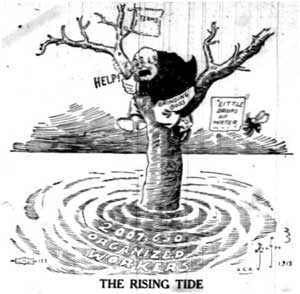
(September
13, 1913)
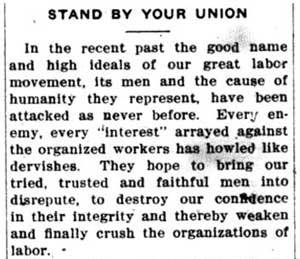
(February
24, 1912)
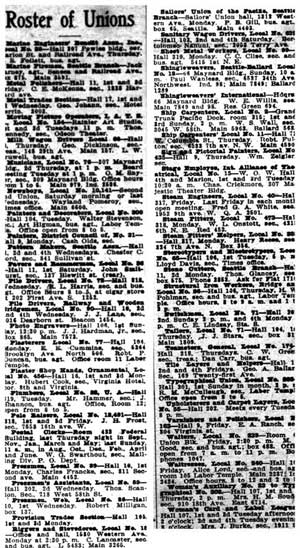
(January
20, 1912)
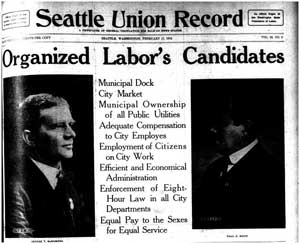
(February
17, 1912)
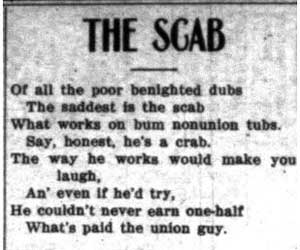
(March
16, 1912)
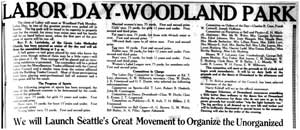
(September
5, 1914)
Race, Gender, and
Immigration
The Seattle Union Record
stressed working-class solidarity. Articles argued that workers
could not afford to be divided on issues of race and ethnicity.
The paper also highlighted women's role in the labor movement and ran
articles in support of suffrage and women's rights.
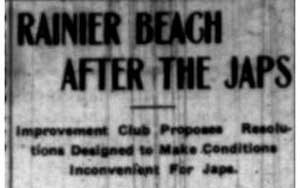
(May
10, 1913)
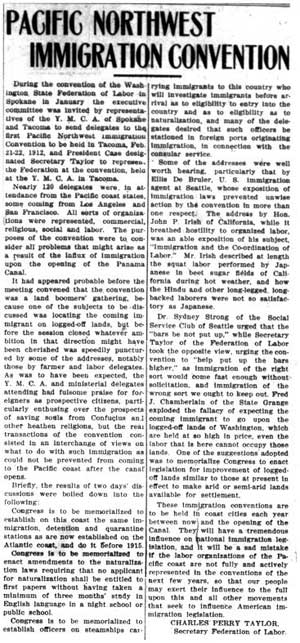
(March
2, 1912)
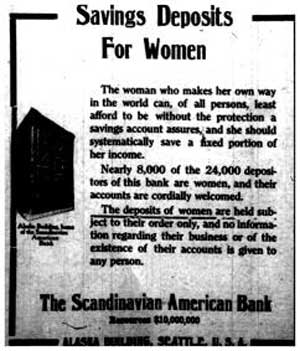
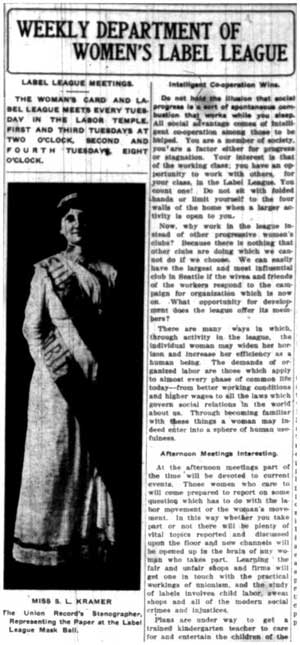
(February
28, 1914)
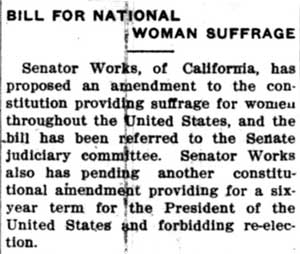
(March
16, 1912)

(May
30, 1914)
The Bon Marche Campaign
During the 1912-1914
period, a struggle between workers and the Seattle retailer, the Bon Marche, was covered in great detail in the Union Record—in
fact, nearly a week went by without an article discussing this dispute.

(May
24, 1913)

(January
10, 1914)
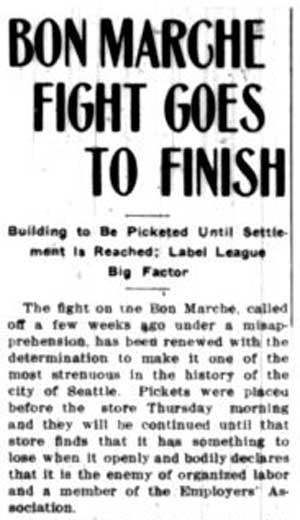
(January
24, 1914)
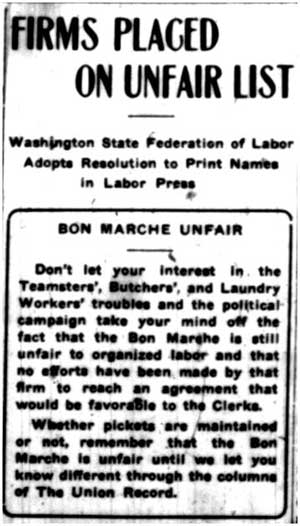
(February
7, 1914)
Supporting The Miners'
Struggle
Perhaps the most heavily covered national labor news of this time
involved the plight of striking miners in Colorado and Michigan. Upset
over horrid conditions and abysmal wages, mine workers demanded changes
from mine owners. The addition of the “Page for the Miners” section
guaranteed weekly coverage of these strikes.
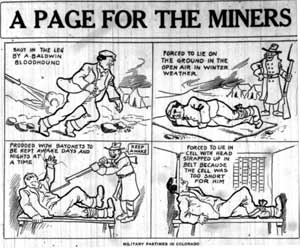
(March
21, 1914) |






















